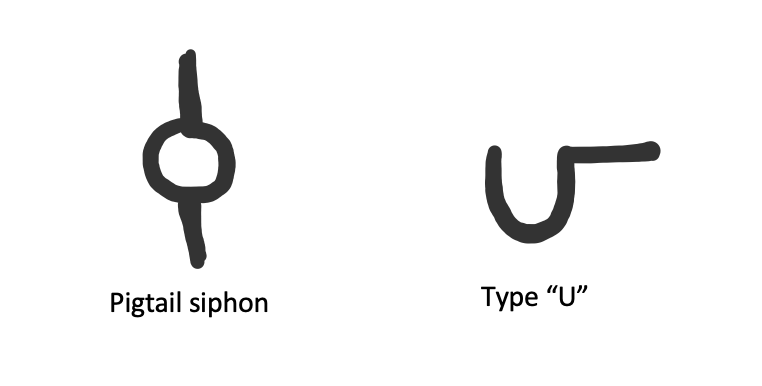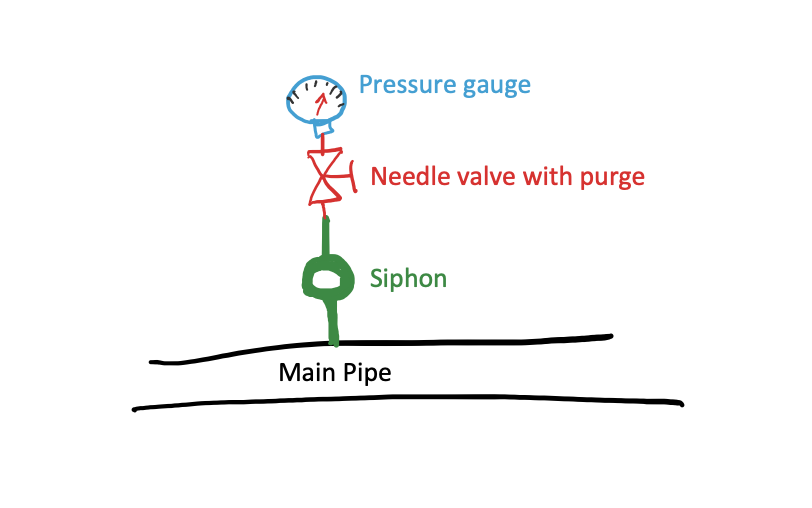The best measurement and instrumentation equipment is generally very sensitive to changes in pressure and temperature, so it is capable of measuring minute variations with high accuracy.
However, this high sensitivity generally comes at a cost. They are also delicate and prone to damage when experiencing extreme conditions such as pressure and temperature spikes outside the operating range of the equipment.
At this point, you must be wondering “so how does pressure measurement equipment withstand working in systems like steam where temperatures and pressures can be very high?” “And what do pigtail siphons have to do with any of this?”.
I’ll tell you the 5 fundamental concepts about pigtail siphons that make them essential for these types of systems.
Let’s get down to business
Before talking about the 5 fundamental concepts we must be clear about what these siphons are. The most basic definition is that pigtail siphons are a type of siphon that is nothing more than a looped pipe, in this case in a spiral similar to a pigtail, hence its name, although sometimes it is also used the name lyre type siphon or just lyre.

These siphons are installed in vapor pressure measurement systems upstream of the pressure measurement equipment, generally known as a pressure gauge, to protect it from the pressure and temperature spikes mentioned above.
But how does a pigtailed pipe protect a pressure gauge? If you’re wondering, the 5 fundamental concepts about pigtail siphons I’m going to introduce you to below will give you the answer.
Let’s take a look
The pigtail siphon allows a phase change to occur before the fluid reaches the pressure gauge. Put more simply, thanks to its design, the vapor that circulates through the siphon at high pressure condenses, so that a part of it passes from a gaseous state to a liquid state and avoids direct contact with the pressure gauge at a very high temperature.
In addition, this condensate is stored in the pigtail siphon or lyre type siphon and allows heat dissipation which allows the temperature to be maintained at levels suitable for the operation of the pressure measuring equipment.
Tip: Sometimes before installation, the siphon is filled with some water or other fluid to achieve phase separation.
Since pigtail siphons are generally used vertically, the condensate generates what is called a liquid seal. This is a great way to protect the metering equipment from pressure spikes and what is known as the whiplash effect can be very damaging to the equipment.

It may appear that the operation of the pigtail siphon interferes with the pressure measurement, but this is not true. The worst that can happen is that some air can get trapped inside the siphon and yet the measurement would not be altered because the air is compressible and the measurement would still be accurate. This is why we often recommend installing a manometer series needle valve with a bleed before the siphon. It allows to bleed the system and ensure a smooth flow into the gauge.

Although this concept is not exactly part of the principle of operation of pigtail siphons, it is important that each siphon is designated for a maximum allowable operating pressure. This is mainly related to the material it is made of and the thickness of the pipe (pipe wall thickness) or also called the Schedule. The thicker the pipe, the more pressure it can withstand. At Redfluid we manufacture siphons of 1/8, 1/4, 3/8, 1/2, 3/4 up to 1″ in schedules 40, 80, 160, and XXS.
For example, at Red Fluid you can find siphons in a wide variety of materials such as Carbon Steel A106B, Stainless Steel T304 T316 316/316L, and Brass, among others, for pressures up to 900 bar.
Siphon materials: A53F, Carbon Steel A106/B, Brass, P11, P22, T304, T316/L, Hastelloy, Alloy20, Duplex, Superduplex; 904, etc. Remember that if we don’t have it we can manufacture it according to your specifications.
The important thing is to select the right one so that the siphon is not blamed for the failure of the measuring equipment. If you want more information you can find the technical data sheet of the pigtail siphons here.
In general, there are 3 connection methods for pigtail siphons. These methods are:
The selection of one or the other will depend on the pressure levels and the type of fluid you are working with. For example, buttweld is usually preferred for high pressures and corrosive or hazardous fluids that could damage a thread and produce leaks that would affect health and safety in the work environment.
On the other hand, it should be noted that the standards for threads have led manufacturers to improve the staking of these threaded connections, and there is a variety to cover different applications, the most standard ones are BSPP, BSPT, or NPT siphons. In the Redfluid pigtail siphons datasheet, you can also see the connection options we offer.
We have calculated for you the pressure that a 1/2″ pig tail siphon can withstand according to ASME Pressure Vessel Code, Section 1, Pg27. You can see the results here. Pressure in bar and temperature in degrees Celsius (ºC).
| wdt_ID | Temperatura en ºC | Carbon Steel Sch40 (STD) SA-106B | Carbon Steel Sch80 (XS) SA-106B | Carbon Steel Sch160 SA-106B SMLS | Carbon Steel XXS SA-106B SMLS | Chrome Moly Steel Sch80 (XS) SA-335 P11 | Chrome Moly Steel Sch160 (XXS) SA-335 P11 | Chrome Moly Steel Sch80 (XS) SA-335 P22 | Chrome Moly Steel Sch160 (XXS) SA-335 P22 | Stainless Steel Sch40 (STD) SA-312 TP304 | Stainless Steel Sch80 (XS) SA-312 TP304 | Stainless Steel Sch160 SA-312 TP304 | Stainless Steel Sch40 (STD) SA-312 TP316 | Stainless Steel Sch80 (XS) SA-312 TP316 | Stainless Steel Sch160 SA-312 TP316 |
|---|---|---|---|---|---|---|---|---|---|---|---|---|---|---|---|
| 1 | -6 | 77 | 166 | 270 | 579 | 270 | 166 | 270 | 579 | 82 | 177 | 288 | 82 | 177 | 288 |
| 2 | 93 | 77 | 166 | 270 | 579 | 270 | 166 | 270 | 579 | 72 | 157 | 256 | 77 | 166 | 270 |
| 3 | 148 | 77 | 166 | 270 | 579 | 270 | 166 | 270 | 579 | 65 | 142 | 230 | 68 | 147 | 240 |
| 4 | 204 | 77 | 166 | 270 | 579 | 270 | 166 | 270 | 579 | 60 | 130 | 211 | 62 | 135 | 220 |
| 5 | 260 | 77 | 166 | 270 | 579 | 270 | 166 | 270 | 579 | 56 | 122 | 198 | 58 | 125 | 203 |
| 6 | 315 | 77 | 166 | 270 | 579 | 270 | 166 | 270 | 579 | 52 | 114 | 185 | 54 | 118 | 193 |
| 7 | 343 | 77 | 166 | 270 | 579 | 270 | 166 | 270 | 579 | 52 | 113 | 184 | 53 | 116 | 189 |
| 8 | 371 | 73 | 160 | 259 | 556 | 270 | 166 | 270 | 579 | 51 | 111 | 180 | 52 | 114 | 185 |
| 9 | 398 | 66 | 144 | 234 | 502 | 267 | 166 | 270 | 579 | 50 | 108 | 176 | 51 | 112 | 182 |
| 10 | 426 | 55 | 120 | 194 | 417 | 259 | 166 | 270 | 579 | 48 | 105 | 171 | 50 | 110 | 178 |
| 11 | 454 | 40 | 86 | 140 | 301 | 252 | 160 | 259 | 556 | 48 | 104 | 169 | 50 | 110 | 178 |
| 12 | 482 | 25 | 55 | 90 | 193 | 245 | 151 | 245 | 525 | 47 | 103 | 167 | 50 | 108 | 176 |
| 13 | 510 | 15 | 33 | 55 | 122 | 172 | 122 | 200 | 442 | 46 | 100 | 162 | 49 | 107 | 175 |
| 14 | 537 | 7 | 17 | 29 | 69 | 123 | 93 | 156 | 371 | 45 | 97 | 158 | 49 | 106 | 173 |
| 15 | 565 | 82 | 66 | 111 | 264 | 44 | 95 | 155 | 48 | 105 | 171 | ||||
| 16 | 593 | 54 | 44 | 74 | 176 | 42 | 93 | 153 | 48 | 106 | 174 | ||||
| 17 | 621 | 37 | 28 | 47 | 111 | 34 | 77 | 129 | 43 | 96 | 162 | ||||
| 18 | 648 | 23 | 16 | 27 | 65 | 27 | 60 | 101 | 33 | 73 | 123 | ||||
| 19 | 676 | 21 | 46 | 78 | 24 | 54 | 92 | ||||||||
| 20 | 704 | 16 | 37 | 62 | 18 | 40 | 68 | ||||||||
| 21 | 732 | 13 | 29 | 48 | 13 | 30 | 50 | ||||||||
| 22 | 760 | 10 | 23 | 39 | 9 | 22 | 37 | ||||||||
| 23 | 787 | 8 | 18 | 31 | 7 | 17 | 29 | ||||||||
| 24 | 815 | 6 | 13 | 23 | 5 | 12 | 21 |
Why choose Redfluid? In addition to the variety of standardized pig tail siphons or loop siphons that we stock, we also offer alternatives such as siphons made of special materials or better yet we can custom manufacture your pig tail siphons.
We have 35 years of experience manufacturing valves, adapters and other custom fittings to meet the needs of our customers. And our engineers are always ready to advise you on what is the best alternative for you.
If you’re ready to buy siphons or have any questions you’d like to ask about pigtail siphons or any of the products and services we offer, contact us now and we’ll see you.
Share this post